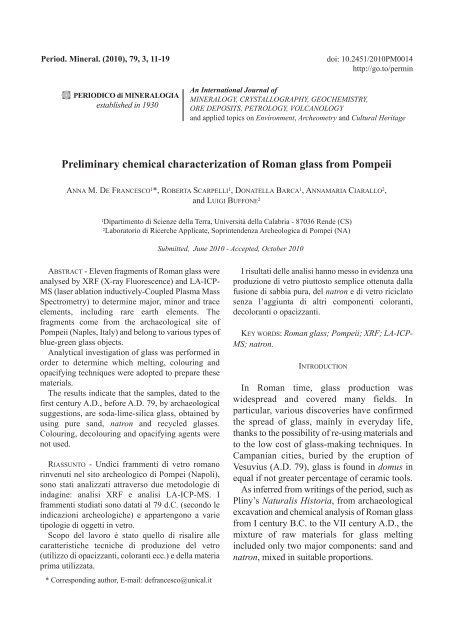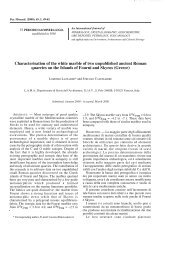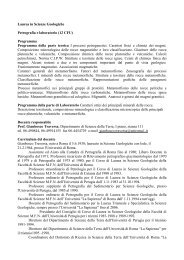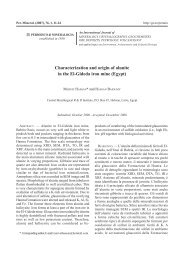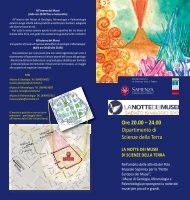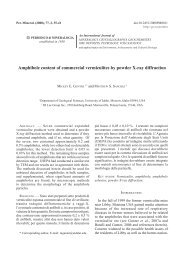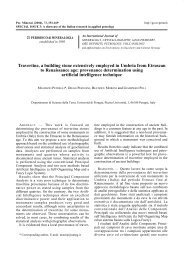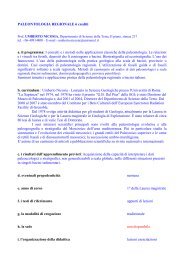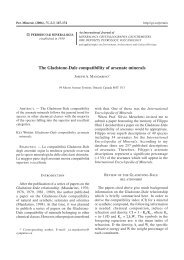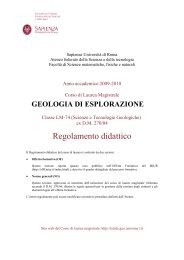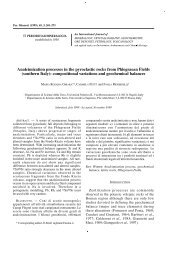Preliminary chemical characterization of Roman glass from Pompeii
Preliminary chemical characterization of Roman glass from Pompeii
Preliminary chemical characterization of Roman glass from Pompeii
You also want an ePaper? Increase the reach of your titles
YUMPU automatically turns print PDFs into web optimized ePapers that Google loves.
Period. Mineral. (2010), 79, 3, 11-19PeRiodico di MineRalogiaestablished in 1930doi: 10.2451/2010pM0014http://go.to/perminAn International Journal <strong>of</strong>MINERALOGY, CRYSTALLOGRAPHY, GEOCHEMISTRY,ORE DEPOSITS, PETROLOGY, VOLCANOLOGYand applied topics on Environment, Archeometry and Cultural Heritage<strong>Preliminary</strong> <strong>chemical</strong> <strong>characterization</strong> <strong>of</strong> <strong>Roman</strong> <strong>glass</strong> <strong>from</strong> <strong>Pompeii</strong>AnnA M. DE FrAnCEsCo 1 *, robErtA sCArpElli 1 , DonAtEllA bArCA 1 , AnnAMAriA CiArAllo 2 ,and luigi buFFonE 21Dipartimento di scienze della terra, università della Calabria - 87036 rende (Cs)2laboratorio di ricerche Applicate, soprintendenza Archeologica di pompei (nA)Submitted, June 2010 - Accepted, October 2010AbstrACt - Eleven fragments <strong>of</strong> roman <strong>glass</strong> wereanalysed by XrF (X-ray Fluorescence) and lA-iCp-Ms (laser ablation inductively-Coupled plasma Massspectrometry) to determine major, minor and traceelements, including rare earth elements. thefragments come <strong>from</strong> the archaeological site <strong>of</strong>pompeii (naples, italy) and belong to various types <strong>of</strong>blue-green <strong>glass</strong> objects.Analytical investigation <strong>of</strong> <strong>glass</strong> was performed inorder to determine which melting, colouring andopacifying techniques were adopted to prepare thesematerials.the results indicate that the samples, dated to thefirst century A.D., before A.D. 79, by archaeologicalsuggestions, are soda-lime-silica <strong>glass</strong>, obtained byusing pure sand, natron and recycled <strong>glass</strong>es.Colouring, decolouring and opacifying agents werenot used.riAssunto - undici frammenti di vetro romanorinvenuti nel sito archeologico di pompei (napoli),sono stati analizzati attraverso due metodologie diindagine: analisi XrF e analisi lA-iCp-Ms. iframmenti studiati sono datati al 79 d.C. (secondo leindicazioni archeologiche) e appartengono a varietipologie di oggetti in vetro.scopo del lavoro è stato quello di risalire allecaratteristiche tecniche di produzione del vetro(utilizzo di opacizzanti, coloranti ecc.) e della materiaprima utilizzata.* Corresponding author, E-mail: defrancesco@unical.iti risultati delle analisi hanno messo in evidenza unaproduzione di vetro piuttosto semplice ottenuta dallafusione di sabbia pura, del natron e di vetro riciclatosenza l’aggiunta di altri componenti coloranti,decoloranti o opacizzanti.KEy worDs: <strong>Roman</strong> <strong>glass</strong>; <strong>Pompeii</strong>; XRF; LA-ICP-MS; natron.introDuCtionin roman time, <strong>glass</strong> production waswidespread and covered many fields. inparticular, various discoveries have confirmedthe spread <strong>of</strong> <strong>glass</strong>, mainly in everyday life,thanks to the possibility <strong>of</strong> re-using materials andto the low cost <strong>of</strong> <strong>glass</strong>-making techniques. inCampanian cities, buried by the eruption <strong>of</strong>Vesuvius (A.D. 79), <strong>glass</strong> is found in domus inequal if not greater percentage <strong>of</strong> ceramic tools.As inferred <strong>from</strong> writings <strong>of</strong> the period, such aspliny’s Naturalis Historia, <strong>from</strong> archaeo logicalexcavation and <strong>chemical</strong> analysis <strong>of</strong> roman <strong>glass</strong><strong>from</strong> i century b.C. to the Vii century A.D., themixture <strong>of</strong> raw materials for <strong>glass</strong> meltingincluded only two major components: sand andnatron, mixed in suitable proportions.
12 A.M. DE FrAnCEsCo, r. sCArpElli, D. bArCA, A. CiArAllo and l. buFFonEVarious studies have aimed at identifying theorigin <strong>of</strong> the raw materials and where the <strong>glass</strong>was produced, according to compositionalvariation and specific isotope ratios (wedepohland baumann, 2000; Freestone et al., 2003). Acommon model is that the ‘raw <strong>glass</strong>’ wasproduced in primary workshops in the MiddleEast, especially palestine (Huisman et al., 2009).strabo and pliny, ancient writers, mention thelevant, especially sand <strong>from</strong> the river belus, asa major source <strong>of</strong> raw materials (Humphrey etal., 1998).the second model proposes local <strong>glass</strong>makingand working centers employing rawmaterials locally available and/or imported. Forexample, silvestri et al. (2006) showed that theCampanian sand is also suitable for <strong>glass</strong>making,but only after selective grinding carriedout according to pliny’s text, which modifies thepristine ratios among single components.Huisman et al. (2009) suggest that possiblediversification <strong>of</strong> primary production in theroman period, is demonstrated when largevariations between the analysed <strong>glass</strong> <strong>of</strong> thesame period <strong>of</strong> time can be found.in the pompeii <strong>glass</strong>, analysed by Vallotto andVerità (2002), modest changes in theconcentration <strong>of</strong> sodium oxide (na 2 o: <strong>from</strong>15.5% to 18.5%) have been observed, with asand/natron ratio (5/2) relatively constant. theseresults suggest that most <strong>of</strong> the analysed findswere melted with sand <strong>from</strong> the same localityand that there was a <strong>glass</strong> production center inpompeii. Most <strong>of</strong> the studied samples <strong>from</strong>pompeii showed a remarkable similarity withsand <strong>from</strong> the river bélus; the discovery in theroman city <strong>of</strong> raw <strong>glass</strong> with this composition,confirms that the local workshops used raw <strong>glass</strong><strong>from</strong> Middle East. is not excluded that othersands, anyway different <strong>from</strong> those <strong>of</strong> Volturnoriver, have been probably used for other finds.(Vallotto and Verità, 2002).this work aims to provide a furthercontribution to the study on pompeii <strong>glass</strong>. themain objective is the <strong>chemical</strong> <strong>characterization</strong><strong>of</strong> <strong>glass</strong> fragments by combining two methods <strong>of</strong>analysis, to identify technological aspects andcompositional variations among differing <strong>glass</strong>objects.MAtEriAls AnD MEtHoDsthe studied <strong>glass</strong> fragments, found in differentinsulae and houses <strong>of</strong> the archaeological site <strong>of</strong>pompeii, belong to various types <strong>of</strong> <strong>glass</strong>ware:balsamaria, jars, cinerary urns, jugs and a sample<strong>of</strong> raw <strong>glass</strong> (Fig. 1). they are dated back to thefirst century A.D., before A.D. 79, year in whichthere was Vesuvius eruption. they are opaquedecorations free and show the same blue-greenFig. 1 - some analysed <strong>glass</strong> samples - a) Balsamaria (up1); b) rim <strong>of</strong> jug (brp1); c) Jar (bp3); d) raw <strong>glass</strong> (rg); e)Drop-shaped balsamaria (up2). (scale is in centimeters)
<strong>Preliminary</strong> <strong>chemical</strong> <strong>characterization</strong> <strong>of</strong> <strong>Roman</strong> <strong>glass</strong> <strong>from</strong> <strong>Pompeii</strong>13tAblE 1Type, presumed age, color and location <strong>of</strong> the analysed <strong>glass</strong>es. The term “Incertae” indicate the indefinite exact place <strong>of</strong>discovery (home, public building, shop, etc...).Sample Type date colour ProvenanceRg raw <strong>glass</strong> pre-79 AD blue-green insula occidentalisBP1 jar pre-79 AD blue-green IncertaeBP2 jar pre-79 AD blue-green Menandro houseBP3 jar pre-79 AD blue-green House n. 32BR4 jar pre-79 AD blue-green insula 3, regio VUP1 balsamaria pre-79 AD blue-green Fauno houseUP2 drop-shaped balsamaria pre-79 AD blue IncertaeUP3 balsamaria pre-79 AD blue-green IncertaeUP4 balsamaria pre-79 AD blue-green IncertaeBRP1 jug pre-79 AD blue IncertaeolP1 cinerary urn pre-79 AD blue-green Incertaehue apart two fragments with a more intense bluecolor. the features <strong>of</strong> the investigated <strong>glass</strong>es aresummarized in tAblE 1.Fragments, subjected to <strong>chemical</strong> XrF andlA-iCp-Ms analysis, were previously cleaned<strong>of</strong> superficial deposits in an ultrasonic bath withMillipore water.the determination <strong>of</strong> the major element bulkcomposition <strong>of</strong> each sample was determined byX-ray fluorescence (XrF) on a bruker s8 tigerspectrometer. the samples was ground to a finepowder in an agate mortar to prepare pressedpellets with boric acid as support. Accuracy wastested on international standards.lA-iCp-Ms analysis was carried out on anElan DrCe-perkin Elmer/sCiEX plasma massspectrometer coupled with a model up213, ndyAglaser (new wave) to determine traceelements and rEE. small pieces <strong>of</strong> about 2x2mm were sampled <strong>from</strong> each <strong>glass</strong> and fixed onslides, with the fresh side facing upward.Calibration was carried out on standard <strong>glass</strong>nist srM 612 (50 ppm) produced by thenational institute <strong>of</strong> standards and technology,also to check the quality <strong>of</strong> analyses the standard<strong>glass</strong> nist srM 610 (500 ppm) was analysedas “unknown”. laser ablation <strong>of</strong> samples wascarried out in the ablation cell with a beamcreating a crater <strong>of</strong> about 50 microns and thevaporized material, was transported by a heliumargonflow to the iCp, where it was quantified(gunther and Heinrich, 1999).lastly, the concentration <strong>of</strong> sio 2 for each <strong>glass</strong>fragment determined by XrF was used, forinternal standardization. to assess the accuracy<strong>of</strong> the analytical data, the mean value <strong>of</strong> analyseson standard nist 610, used for quality control,was compared with those reported in theliterature (pearce et al., 1997; Dulski, 2001; gaoet al., 2002). Accuracies expressed as percent
<strong>Preliminary</strong> <strong>chemical</strong> <strong>characterization</strong> <strong>of</strong> <strong>Roman</strong> <strong>glass</strong> <strong>from</strong> <strong>Pompeii</strong>15tAblE 3Results <strong>of</strong> LA-ICP-MS analysis performed on 11 <strong>Pompeii</strong> <strong>glass</strong> samples. Trace elements are expressed in ppm.Rg BP1 BP2 BP3 BP4 UP1 UP2 UP3 UP4 BRP1 olP1cr 20.1 10.14 17.4 14.6 10.1 18.9 22 19 18.7 22.8 15.5Sc 2.89 1.32 3.26 3.52 2.01 3.72 5.03 nd 2.35 4.07 3.03V 10.8 6.58 12.3 13.2 8.19 11.9 14.4 12.5 13.6 13 12.3co 3.31 1.93 11.3 16 2.99 15.1 29 12.7 15.4 21 16.6cu 6.73 4.66 332 309 4.30 260 306 28.6 127 374 206ni 8.02 4.86 6.37 8.34 5.62 7.30 7.76 8.91 9.25 8.07 7.74Zn 8.06 11 18.6 20.9 11.1 24.3 19 23.6 26.7 24.5 26.7as 4.03 2.69 5.29 3.52 2.05 nd 15.6 nd 4.08 6.43 3.86Rb 8.88 6.38 22.6 9.56 7.45 8.64 12.7 7.62 9.47 11.3 9.27Sr 519 441 413 412 475 397 472 491 433 463 385Y 8.23 7.23 7.32 6.90 7.18 6.76 8.59 7.93 7.51 7.98 6.82Zr 33.7 31.8 49.4 49.3 33.5 53.9 60.3 42.2 44.4 65.4 48nb 1.38 1.15 1.82 1.89 1.41 1.81 1.37 1.58 1.66 2.33 1.64Mo 1.97 1.55 1.21 1.52 1.86 2.18 1.48 1 1.3 2.64 0.96ag nd nd 0.39 0.31 0.16 0.74 nd 0.36 1.03 0.10 0.20cd 5.28 14.3 7 6.4 19 34.36 6.32 nd 7.98 12.5 4.04Sn 1.16 0.53 62.4 60.3 1.02 37.7 42.9 8.52 24.6 72.2 40.9Sb 7.66 nd 661 718 0.20 668 894 114 722 916 729Ba 229 228 225 253 255 233 264 245 263 283 212la 6.70 6.35 7.56 6.79 6.96 6.64 8.50 7.45 6.93 8.41 6.77ce 11.2 11. 5 13.6 12.2 12.3 10.6 14.2 12.2 12.7 15 11.3Pr 1.63 1.42 1.48 1.55 1.60 1.67 1.87 1.58 1.72 2.09 1.53nd 6.52 6.17 6.96 6.85 7.19 7.18 5.89 5.63 7.26 8.34 5.50Sm 1.47 1.43 1.69 1.14 1.77 2.53 1.56 2.77 2.06 1.65 1.11eu 0.30 0.29 0.28 0.30 0.27 0.39 0.98 0.32 0.34 0.26 0.36gd 1.09 1.54 1.15 1.14 1.24 1.33 2.50 2.76 1.80 1.65 0.93Tb 0.23 0.21 0.21 0.20 0.15 0.40 0.86 0.10 0.20 0.16 0.13dy 1.10 1.07 1.09 1.20 1.40 1.38 0.32 2.02 1.12 1.66 0.94Ho 0.20 0.30 0.18 0.28 0.25 0.57 0.77 0.32 0.31 0.25 0.31er 0.93 0.50 0.70 0.47 1.07 nd 1.96 0.57 0.98 1.33 0.69Tm 0.11 0.10 0.09 0.08 0.04 0.33 0.16 0.12 0.13 0.17 0.06Yb 0.73 0.23 0.87 0.85 0.44 nd 1.40 1.17 0.69 0.33 0.27lu 0.09 0.06 0.13 0.12 0.19 0.60 0.33 0.13 0.10 0.12 0.05Hf 0.60 0.85 1.33 1.30 0.92 1.40 1.88 0.01 1.45 1.87 0.76Ta 0.17 0.04 0.14 0.14 0.12 0.30 0.32 0.14 0.03 0.21 0.04Pb 7.19 3.99 326 202 5.32 143 222 31.1 146 202 161Th 0.88 0.84 1.82 1.21 0.93 1.29 1.61 1.31 1.32 1.51 1.17U 1.21 1.04 1.09 0.88 1.14 1.04 1.60 1.18 1.07 1.30 1.06
16 A.M. DE FrAnCEsCo, r. sCArpElli, D. bArCA, A. CiArAllo and l. buFFonEslight compositional differences between <strong>glass</strong>samples may be a result <strong>of</strong> variations in <strong>glass</strong>production at a single site or the use <strong>of</strong><strong>chemical</strong>ly similar raw materials at differentproduction sites in the same area.the Mgo versus K 2 o plot (Fig. 2a) indicatesthe use <strong>of</strong> natron as <strong>chemical</strong> flux, confirmed bythe relatively low Mgo and K 2 o concentrations,with values not exceeding 1% wt (Mirti et al.,2008).the sio 2 versus na 2 o plot (Fig. 2b) shows theconsiderable homogeneity among the <strong>glass</strong>fragments. only the raw <strong>glass</strong> sample (rg) haslower sio 2 values (66,3 % wt) and higher na 2 opercentage (21,9 % wt) than the other samples.However the different ratio between sio 2 andna 2 o, respectively vitrifier and flux, may beexplained by considering the different use towhich the <strong>glass</strong> would be put. the intentionaladdition <strong>of</strong> na 2 o, favoring <strong>glass</strong> melting, maderaw <strong>glass</strong> suitable for making objects for casting,such as <strong>glass</strong> sheet (Verità et al., 2001; Verità,2004).the low contents <strong>of</strong> Al 2 o 3 and Cao (Fig. 3a)are indicative <strong>of</strong> the use <strong>of</strong> a pure and <strong>of</strong> goodquality, quartz-rich sand, as also shown by theFig. 2 - Major element concentrations in pompeii <strong>glass</strong> - a) Mgo versus K 2 o; b) sio 2 versus na 2 o.Fig. 3 - Major element concentrations in pompeii <strong>glass</strong> - a) Al 2 o 3 versus Cao; b) Fe 2 o 3 versus Mno.
<strong>Preliminary</strong> <strong>chemical</strong> <strong>characterization</strong> <strong>of</strong> <strong>Roman</strong> <strong>glass</strong> <strong>from</strong> <strong>Pompeii</strong>17low Fe 2 o 3 (up to 0,62 % wt, Fig. 3b) and traceelements contents (tAblE 3) according toFreestone et al., 2002.the low percentages <strong>of</strong> Mno (less than 0.65%wt) show that manganese oxide as decolouringagent was not used as according to commonroman <strong>glass</strong> production (Mirti et al., 2008), butits presence in most <strong>of</strong> studied samples suggestsdeliberate addition at some point during themanufacture. Considering that the Mno/Feo ratioin the Earth’s crust is about 0,015 (wedepohl,1995), instead in the bp1, bp3, up1, up2, brp1and olp1 samples it is about 1, the contaminationby recycling manganese-decoloured <strong>glass</strong>es issuggested (Freestone, 2006).some correlation exists between the titaniumand iron concentrations (tAblE 2), probablyintroduced into the melting bath as contaminants<strong>from</strong> sand and flux (Mirti et al., 1993).Trace elementsthe sb versus pb diagram (Fig. 4a) showsmarked variability among the analysed samplesand a high correlation between lead andantimony. the presence <strong>of</strong> antimony in <strong>glass</strong> isgenerally associated with the use <strong>of</strong> adecolorizer, a procedure which becamewidespread in <strong>glass</strong> production in the MiddleEast <strong>from</strong> the second half <strong>of</strong> the first millenniumb.C., to the late i century b.C. in Europe,antimony continued to be used beyond the iicentury AD, together with manganese, whichwas most frequently used in the i century A.D.(Arletti et al., 2008).in the studied <strong>glass</strong> samples, antimony isfound in concentrations ranging <strong>from</strong> a few ppmto about 900 ppm. its presence as a decolorizercan be excluded, as its content does not exceed0.2% wt (Jackson, 2005). However the relativelyhigh amounts <strong>of</strong> sb in most studied samplescould be due by the addition <strong>of</strong> recycledantimony-decoloured <strong>glass</strong>es (Freestone et al.,2002).Even the relatively low contents <strong>of</strong> pb confirmthat neither lead antimonate or bindheimite(pb 2 (sb,bi) 2 o 6 (o.oH)), generally included asdecolorizer (Jackson, 2005), was used.the diagram in fig.4b (Co versus Cu) show ingeneral the low contents <strong>of</strong> Co (up to 29 ppm)and variable Cu concentrations (below 374ppm). this confirms that colorizing agents, suchas trianite (2Co 2 o×Cuo×6H 2 o) found usually inblue <strong>glass</strong> (Arletti et al., 2008), were not used.the brp1 and up1 <strong>glass</strong> fragments,characterized by a more intense blue hue, showhigher contents <strong>of</strong> Cu and Co, probably due bythe employ <strong>of</strong> recycled <strong>glass</strong>es (Freestone et al.,2002).Fig. 4 - trace element concentrations in pompeii <strong>glass</strong> - a) sb versus pb; b) Co versus Cu.
18 A.M. DE FrAnCEsCo, r. sCArpElli, D. bArCA, A. CiArAllo and l. buFFonEFurthermore the presence <strong>of</strong> Cu, pb and sn indifferent levels and in different relative amounts,could indicate that recycling <strong>of</strong> bronze slag wasa more or less usual practice in <strong>glass</strong> production(Mirti et al., 2009). However the contaminationby the manufacture <strong>of</strong> bronze materials in thesame site, cannot be excluded. independently <strong>of</strong>the actual origin <strong>of</strong> copper in <strong>glass</strong>, it contributessignificantly to the development <strong>of</strong> its blue-greenhue.the two jars (bp1 and bp4) and the raw <strong>glass</strong>(rg) samples evidence negligible contents <strong>of</strong>sb, Mn, pb, Co and Cu (Fig. 3b, Fig.4a and 4b)suggesting that the analysed <strong>glass</strong> probably weremelted using different proportions <strong>of</strong> recycledand raw <strong>glass</strong> or may be related to differentsecondary productions.information on the kind <strong>of</strong> sand used in ancient<strong>glass</strong> manufacture can further be obtained byconsidering the strontium content. the strontiumconcentration in the samples is not very variableand falls in the range 385-519 ppm and mayindicate the use <strong>of</strong> coastal sand as a source <strong>of</strong>silica (Van der linden et al., 2009), althoughisotope analysis is required to confirm this.relatively low contents <strong>of</strong> titanium,zirconium, hafnium and rare earth elements(tAblE 2 and 3) suggest recourse to a quite puresand (Mirti et al., 2009).ConClusionsthe preliminary study on pompeii <strong>glass</strong>provided information on raw materials andworking techniques.Major elements concentrations defined the <strong>glass</strong>as silica-soda-lime, with typical homogeneouscomposition <strong>of</strong> roman <strong>glass</strong>. it was producedwith the same pure coastal sand and using natron,as a flux.For the low number <strong>of</strong> analysed <strong>glass</strong>ware nohypotheses can be put forward concerning thesite where the raw <strong>glass</strong> was produced <strong>from</strong> rawmaterials.the low contents <strong>of</strong> Fe, Co, Mn and sbindicate that colouring and decolouring agentswere not employed but evidence that recycling<strong>of</strong> decoloured and coloured <strong>glass</strong>es was widelypracticed in pompeii town. the presence <strong>of</strong> Cu,sn and pb in <strong>glass</strong> samples, is attributedprobably to the employ <strong>of</strong> slag <strong>from</strong> the bronzemanufacturing for <strong>glass</strong> production or as simplecontamination.trace elements contents could suggest differentsecondary <strong>glass</strong> productions in pompeii ordifferent melting processes in the same workshop.ACKnowlEDgEMEntswe are really grateful to the Editor and the refereespr<strong>of</strong>. ian Freestone and pr<strong>of</strong>. Koen Janssens for theirpositive criticism, which certainly leads to animprovement <strong>of</strong> the manuscript.rEFErEnCEsArlEtti r., VEZZAlini g., biAggio siMonA s. andMAsElli sCotti F. (2008) - Archaeometrical studies<strong>of</strong> <strong>Roman</strong> Imperial Age <strong>glass</strong> <strong>from</strong> Canton Ticino,Archaeometry, 50, 606-626.DulsKi p. (2001) - Reference materials forgeo<strong>chemical</strong> studies: new analytical data by ICPMSand critical discussion <strong>of</strong> reference values.geostandards newletter: geostand. geoanal. res.,25, 87-125.FrEEstonE i.C., ponting M. and HugHEs M.J. (2002)- The origin <strong>of</strong> Byzantine <strong>glass</strong> <strong>from</strong> MaroniPetrera, Cyprus, Archaeometry, 44, 257–72.FrEEstonE i.C., lEsliE K.A., tHirlwAll M. andgorin-rosEn y. (2003) - Strontium isotopes in theinvestigation <strong>of</strong> early <strong>glass</strong> production: Byzantineand early Islamic <strong>glass</strong> <strong>from</strong> the Near East,Archaeometry, 45, 19-32.FrEEstonE i. (2006) - Glass production in LateAntiquity and the Early Islamic period: ageo<strong>chemical</strong> perspective, <strong>from</strong> MAggEtti M. andMEssigA b., geomaterials in Cultural Heritage,geological society, london, special publications,257, 201-216.gAo s., liu X., yuAn H., HAttEnDorF b., guntHErD., CHEn l. and Hu s. (2002) - Determination <strong>of</strong>
<strong>Preliminary</strong> <strong>chemical</strong> <strong>characterization</strong> <strong>of</strong> <strong>Roman</strong> <strong>glass</strong> <strong>from</strong> <strong>Pompeii</strong>19forty-two major and trace elements in USGS andNIST SRM <strong>glass</strong>es by laser ablation-inductivelycoupled plasma mass spectrometry. geostandardsnews letter: geostand. geoanal. res., 26, 181-196.guntHEr D. and HEinriCH C.A. (1999) - Enhancedsensitivity in laser ablation-ICP mass spectrometryusing helium-argon mixtures as aerosol carrier, J.Anal. spectr., 14, 1363-1368.HEnDErson J. (1985) - The raw materials <strong>of</strong> early<strong>glass</strong> production, oxford J. Archaeol., 4, 267-91.HEnDErson J. (2002) - Tradition and experiment infirst millennium A.D. <strong>glass</strong> production-theemergence <strong>of</strong> early Islamic <strong>glass</strong> technology in LateAntiquity, Accounts <strong>of</strong> Chemical research, 35, 594-602.HuisMAn D.J., DE groot t., pols s. and VAn osb.J.H., DEgrysE p. (2009) - Compositionalvariation in roman colourless <strong>glass</strong> objects <strong>from</strong> theBocholtz burial (the Netherlands), Archaeometry51, 413-439.HuMpHrEy J.w., olEson J.p. and sHErwooD A.n.(1998) - Greek and <strong>Roman</strong> technology, a sourcebook, routledge, london.JACKson C.M. (2005) - Making colourless <strong>glass</strong> in the<strong>Roman</strong> period, Archaeometry, 47, 763-80.Mirti p., CAsoli A. and AppoloniA l. (1993) -Scientific analysis <strong>of</strong> <strong>Roman</strong> <strong>glass</strong> <strong>from</strong> AugustaPraetoria, Archaeometry, 35, 2, 225-240.Mirti p., pACE M., nEgro ponZi M.M., ACEto M.(2008) - ICP-MS analysis <strong>of</strong> <strong>glass</strong> fragments <strong>of</strong>parthian and sasanian epoch <strong>from</strong> Seleucia anchVeh Ardasìr (Central Iraq), Archaeometry, 50, 3,429-450.Mirti p., pACE M., MAlAnDrino M. and nEgro ponZiM. (2009) - Sasanian <strong>glass</strong> <strong>from</strong> Veh Ardasır: newevidences by ICP-MS analysis, J.Arch. sci., 36,1061-1069.pEArCE n.J.g., pErKins w.t., wEstgAtE J.A.,gorton M.p., JACKson s.E., nEAl C.r. andCHEnEry s.p. (1997) - A compilation <strong>of</strong> new andpublished major and trace element data for NISTSRM 610 and NIST SRM 612 <strong>glass</strong> referencematerials, geostandards newsletter: J. geostand.geoanal. res, 21, 115-144.sAyrE E.V. and sMitH r.w. (1967) - Some materials<strong>of</strong> <strong>glass</strong> manufacturing in antiquity, inArchaeological chemistry (ed. M. levey), 279-311,university <strong>of</strong> pennsylvania press, philadelphia.sHortlAnD A.J. (2004) - Evaporites <strong>of</strong> the wadinatrun: seasonal and annual variation and itsimplication for ancient exploitation. Archaeometry46, 497-516.silVEstri A., Molin g. and sAlViulo g. (2005) -<strong>Roman</strong> and medieval <strong>glass</strong> <strong>from</strong> the Italian area,Archaeometry, 47, 4, 797-816.silVEstri A., Molin g. and sAlViulo g. (2006) - Sandfor <strong>Roman</strong> <strong>glass</strong> production: an experimental andphilological study on source <strong>of</strong> supply, Archaeometry,48, 415-32.VAllotto M. and VErità M. (2002) - Glasses <strong>from</strong><strong>Pompeii</strong> and Herculaneum and the sands <strong>of</strong> therivers Belus and Volturno, in Homo Faber - studieson nature, technology and science at the time <strong>of</strong>pompeii, a cura di J. renn, g. Castagnetti, roma,pp. 63-73.VAn DEr linDEn V., Cosyns p., sCHAlM o., CAgnos., nys K., JAnssEns K., nowAK A., wAgnEr b. andbulsKA E. (2009) - Deeply coloured and black <strong>glass</strong>in the northern provinces <strong>of</strong> the roman empire:differences and similarities in <strong>chemical</strong> compositionbefore and after AD 150, Archaeometry 51, 5, 822-844.VErità M., proFilo b. and CAnCElliErE s. (2001) -Analisi di reperti vitrei, in la casa di giulio polibio- studi interdisciplinari. Ed. Centro studi ArtiFigurative - università di tokio, pp. 155-162.VErità M. (2004) - Natura e tecnologia dei vetripompeiani attraverso le analisi chimiche deireperti, in VitruM - il vetro fra arte e scienza nelmondo romano, giunti editore, pp 163-167.wEDEpoHl K.H. (1995) - The composition <strong>of</strong> thecontinental crust, geochi. Cosmochi. Acta, 59,1217-1232.wEDEpoHl K.H. and bAuMAnn A. (2000) - The use <strong>of</strong>marine molluskan shells for <strong>Roman</strong> <strong>glass</strong> and localraw <strong>glass</strong> production in the Eifel area (westernGermany), naturwissenschaften, 87, 129-32.


